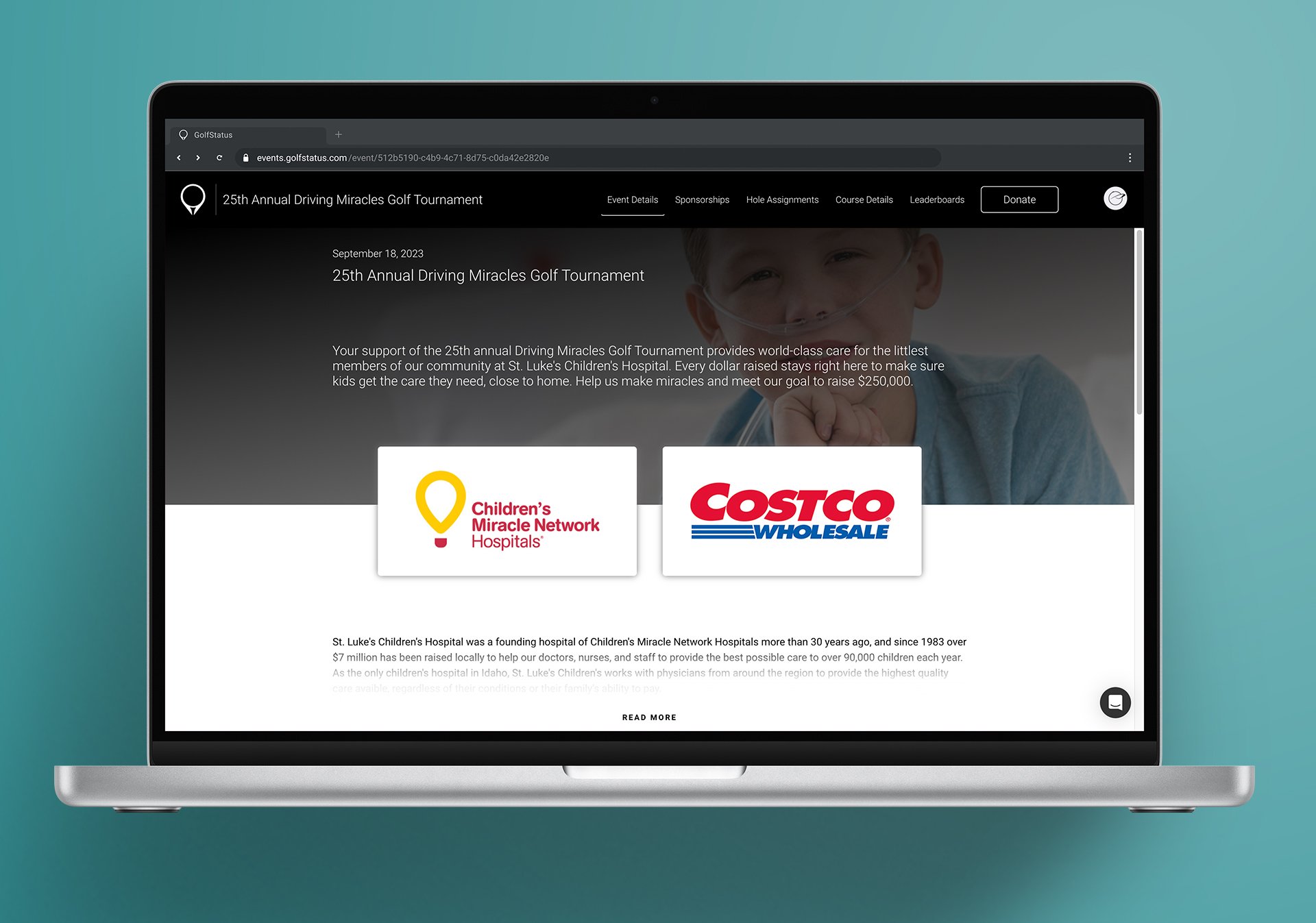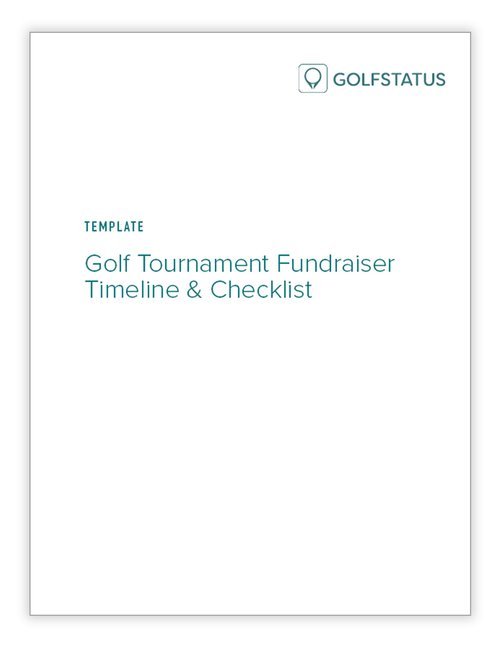Organizing a Charity Golf Tournament: Key Tips & Checklist
by Jen Wemhoff, Communications Manager at GolfStatus
If you’ve never planned a golf tournament before or your organization doesn’t currently have a golf event as part of its fundraising portfolio, you’re likely wondering about what it takes to raise money with golf. Planning a successful golf fundraiser starts with a solid understanding of some fundamentals, paired with a golf tournament checklist to keep you on task and on target.
What to Know Before Organizing a Charity Golf Tournament
You don’t have to be a golf expert.
Most of your fundraising revenue goes to your cause.
Golf events are more popular than ever before.
Golf events bring new donors to the table.
Sponsors are interested in connecting with your donors in new ways.
Golf tournaments are fun and exciting.
Organizing a charity golf event is worth the work.
Use a checklist to stay organized.
1. YOU DON’T HAVE TO BE A GOLF EXPERT.
Many event planners aren’t golfers—and don’t need to be to hold a lucrative golf tournament. All that’s really needed is a tool that helps organizers, committees, and volunteers navigate the intricacies of a golf event and that’s purposefully designed to save novice and seasoned golf event planners time and resources.
An event management platform designed specifically for golf fundraisers makes things easier and walks you through planning and executing every step on your golf tournament fundraiser checklist. Look for a tool that makes it easy to collaborate and exchange information with the golf facility and one with a responsive customer success team that’s there when you need them.
2. GOLF FACILITIES ARE EAGER TO HOST GOLF TOURNAMENTS.
Outside golf outings like memorial tournaments, charity outings, major fundraisers, and small local events are essential to a golf facility’s bottom line. You’re essentially guaranteeing the course that you’ll fill the tee times for the day, plus any additional revenue from the pro shop and food and beverage, not to mention exposure to avid golfers who could become members. This gives you, the event organizer, leverage when it comes to negotiating better pricing for the event. Certainly, the more high-end the facility, typically the higher the green fees will be. That said, here are some things to consider to maximize the cost-effectiveness of the facility:
Tap into your networks. Ask board members, volunteers, and other supporters who are members at higher-end facilities if they have connections and can facilitate a favorable rate.
Hold the event on an off day. Try to avoid busy holiday weekends and other high-traffic dates for courses. Ask about slower days of the week; rates on Mondays, for example, are typically lower than rates on Fridays or Saturdays.
Consider adding a virtual option. A virtual tournament extends the event to multiple days or weeks and/or across multiple courses. With this option, players and teams participate on their own time, scheduling their tee times directly with the facility, so your organization doesn’t actually need to occupy the facility on a specific date for a specific period of time. You can also consider holding a virtual event in tandem with a traditional one-day event to allow for more participants and revenue.
3. GOLF EVENTS ARE MORE POPULAR THAN EVER BEFORE.
Golf has seen record-setting popularity over the past few years. Nationwide, the game has seen a net game of more than 2.3 million on-course golfers since 2020. More than 123 million Americans consumed golf in some way in 2023, an increase of 14% over the past five years. Retail equipment sales continue to remain strong.
Golf fundraisers have enjoyed a similar surge in popularity, with nonprofits of all sizes launching first-year tournaments to capitalize on golfers’ eagerness to get on to the course. These fundraisers are now building on their success as third or even fourth-year events! Golf outings may have emerged as a viable option for in-person fundraising events, but organizations discovered how these events connect them to exactly the types of donors and sponsors that turn into sustainers and long-term corporate partners.
4. GOLF EVENTS BRING NEW DONORS TO THE TABLE.
In general, golfers tend to represent an affluent, influential demographic. Its participants report higher household and discretionary income (more than double the national average) and thus a higher capacity to give. Younger golfers are also increasingly taking up the sport, with more on-course golfers between the ages of 18 and 34 than any other segment.
When golfers tap into their personal and professional networks to field a team (particularly in tournaments with a scramble format that allows for a wider range of skill levels), it instantly broadens your prospective donor base and exposes new people to your mission. What’s more, your tournament’s sponsors give your development and major gift teams an “in” to potential high-capacity donors and corporate partners. Indeed, golf presents an opportunity to connect with new sponsors and supporters through a sport that people want to play. There’s never been a better time to get in front of golfers and sponsors eager to support golf events.
5. SPONSORS ARE INTERESTED IN CONNECTING WITH YOUR DONORS IN NEW WAYS.
High quality, professional golf course signage certainly has its place in terms of sponsor recognition, but sponsors are increasingly looking for avenues to both support organizations and get their brands in front of the affluent golfer demographic. The good news for both nonprofits and sponsors is that the same technology that streamlines golf events opens doors for digital sponsorship exposure. Digital sponsorships can be sold at a premium, giving sponsors exposure to an audience they can’t get anywhere else and offering a high return on their investment.
Corporate partners and sponsors have a vested interest in supporting the tech that helps organizations streamline clerical tasks and eliminate duplicative work. Plus digital exposure is easy to manage—just plug in a logo on a website, in a mobile app, or on your event’s live leaderboards. These methods take less time and effort, have little to no overhead costs, and have substantially lower expenses compared to traditional branded pieces.
What’s more, golf tournaments offer sponsors high engagement over the course of several hours on the course. Whether it’s sponsoring a golfer-favorite hole-in-one contest, setting up a booth on a tee box as a hole sponsor, or running an on-course game, golf events give sponsors the opportunity to engage with participants in meaningful ways.
6. GOLF TOURNAMENTS ARE FUN & EXCITING.
The difference between a good golf event and a great golf event is the overall experience. There are many ways to add fun and excitement (and raise a few more dollars along the way). On-course competitions like hole-in-one contests, longest drive contests, closest-to-the-pin contests, and putting contests let golfers test their luck (or skill) to win great prizes—and are premium sponsorship opportunities.
For example, you can add a buy-in to your tournament’s skins games, which creates mini-competitions between individuals or teams. Displaying skins results on real-time leaderboards keeps golfers engaged.
Other fun add-ons might include:
A celebrity appearance
A professional long-driver on a designated hole or holes
Games or demonstrations on each tee box
Custom player gifts
Live or silent auctions
Post-golf entertainment
The options are endless—but the key is to choose components that contribute to a well-executed event and memorable experience that will keep golfers and sponsors coming back year after year.
7. ORGANIZING A CHARITY GOLF EVENT IS WORTH THE WORK.
Golf’s fundraising capacity is unmatched. And while golf events have a number of moving pieces and unique details to handle, the right tools can ease the administrative burden as you tick items off of your golf tournament fundraiser checklist. Golf event management tech eliminates manual registration and payment processes and siloed information, making it easier to collaborate and delegate tasks to teams, board members, volunteers, and even staff at the golf facility.
Your golf event management software should have robust reporting capabilities so you can easily track payments and who is supporting your cause. It should also handle golf-specific tasks, such as:
Building custom sponsorship packages
Syncing GHIN handicaps
Simplifying team pairings
Streamlining hole assignments and hole-by-hole sponsor exposure
Making live-scoring super simple
If you’re a third party—a business, corporate entity, passionate volunteers, or other group—holding a golf tournament to raise money for a charity, your event management platform should be able to serve as the “bank” for your tournament. Funds collected through donations or purchases of teams, sponsorships, and add-ons can be held by the platform and distributed directly to the benefiting charity after the tournament is complete.
Truly, a fundraising platform designed specifically for charity golf tournaments ensures that no detail is missed. Look for the solution that leaves organizers free to recruit players and sponsors, solicit donations, and upsell and steward donor relationships in ways that advance the event and the organization forward.
Golf Tournament Fundraiser Checklist
A checklist, with an accompanying timeline of tasks, is a tried and true method to staying organized throughout the golf tournament planning process. Depending on the size, scope, and goals of your golf event, a good recommendation is to give yourself at least four to six months to plan. An event management platform built for golf is also a must-have to streamline the process and keep everything organized in one place.
Here’s a quick checklist of important tasks and to-dos to get you started.
3-6 Months Out: Laying the Foundation
Outline goals and objectives for the tournament based on your mission and fundraising goals
Assemble a planning committee
Get your golf tournament management software in place
Set a budget based on how much you aim to raise, income streams, and estimated expenses
Choose a date and host golf facility for the tournament
Start outlining team and sponsor pricing
Launch an event website
Create a marketing plan for the event
Determine whether you’ll have any add-ons, like contests, on-course games, raffle drawings, or an auction
2-5 Months Out: Big-Picture Finalization
Finalize sponsorship offerings and team packages
Get quotes from vendors
Meet with your planning team
Reach out to prospective sponsors
Promote the tournament
1-2 Months Out: Countdown Preparation
Continue promotion and marketing to sell teams
Meet with your planning team
Finalize on-course games and purchase hole-in-one insurance
Determine a contingency plan for inclement weather
Recruit volunteers and determine roles
Continue sponsor outreach
2 Weeks Out: Final Touches
Meet with the planning team to tie up any loose ends
Finalize details and food and beverage with the golf facility
Check on outstanding vendor orders
Close registration
1 Week Out: Crunch Time
Collaborate with the golf facility to finalize team pairings, hole assignments, logistics, vendor deliveries, and setup
Gather supplies and materials (registration items, signage, banners, golfer gifts, raffle prizes, auction items, etc.)
The Big Day
Set up registration, signage, contests, screens for leaderboards, and awards
Take photos and post on social media
Take time to connect with sponsors to build donor relationships
1-2 Weeks Post-Event: Following Up
Export the donor data from your event management software to include in your nonprofit’s CRM
Debrief with your planning team to review goals, outcomes, and improvements for next year
Report on the event’s success to donors, volunteers, and sponsors
Send thank yous to event sponsors and participants
For a more in-depth list of planning tasks with a customizable timeline, download GolfStatus’ free Golf Tournament Fundraiser Timeline and Checklist.
Final Thoughts & Next Steps
Golf tournaments offer a ton of fundraising potential. Understanding the basics of charity golf events and staying organized and on track are keys to planning a successful golf tournament. Start by getting a golf event management platform in place as soon as possible, then outlining all your priorities and to-dos in a golf tournament fundraiser planning checklist.
Get qualified to use GolfStatus’ tournament management software at no upfront cost through the Golf for Good program! You’ll save 40 hours or more in planning time and get access to tools to help you raise thousands more dollars for your cause. Click below to connect with our team and get started.
About the Author
Jennifer Wemhoff - Communications Manager at GolfStatus
Jen Wemhoff accidentally discovered her passion for nonprofits in college. An internship while earning a degree in Communications from Doane University led to a 20 year career in the nonprofit sector, where she found a strong desire to be part of something bigger than herself. Her vast nonprofit experience includes roles in marketing, fundraising, and direct programming. When Jen came to GolfStatus as Communications Manager in 2020, she was struck by the power of the sport to raise money to power nonprofit missions. She tells GolfStatus’s story across platforms and channels and develops educational tools and resources to help nonprofits tap into golf’s giving power. Jen, her husband, and two daughters call Lincoln, Nebraska home.





